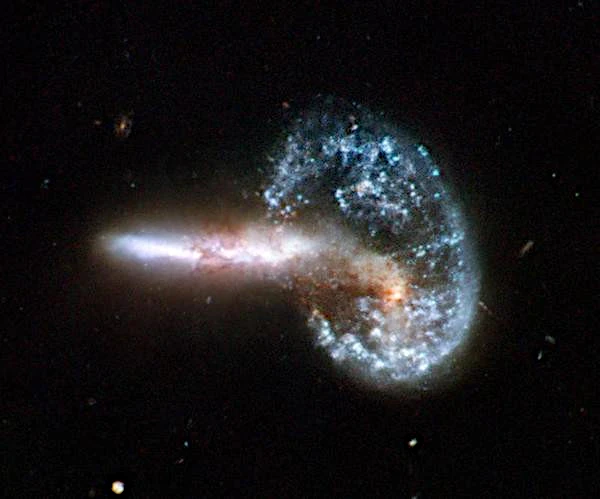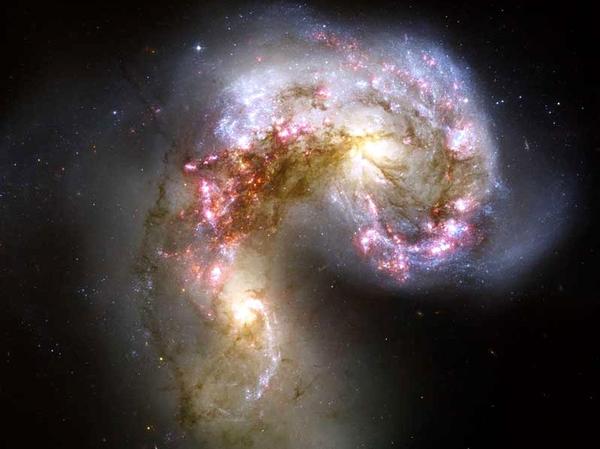
Galaxy mergers are among the most spectacular and fundamental phenomena in cosmology. Contrary to the static image one might have of the Universe, galaxies are not fixed entities but constantly evolve, drawing closer and merging under the influence of gravitational force. The total duration of a complete merger can range from 0.5 to 2 billion years, depending on the mass of the galaxies and their trajectories. In galaxy clusters, these events contribute to the hierarchical formation of large-scale structures.
A galaxy merger is a major cosmic event that alters morphology, triggers starbursts, and can fuel central black holes. Fritz Zwicky (1898-1974) was one of the first to study these interactions and their role in galactic evolution.
When two galaxies come close enough, their mutual attraction initiates a complex cosmic dance. The gravitational force between two masses is expressed by Newton's law of universal gravitation: \(F = G \frac{m_1 m_2}{r^2}\), where \(G\) is the gravitational constant, \(m_1\) and \(m_2\) are the masses of the galaxies, and \(r\) is the distance between them.
The first phase begins when two galaxies enter each other's gravitational sphere of influence. At this stage, tidal forces begin to distort their structure, creating perturbations that will gradually amplify.
Under the influence of tidal forces, galaxies develop characteristic elongated structures: tidal tails and bridges. These spectacular extensions can stretch tens of thousands of light-years and are composed of stars, gas, and dust torn from the parent galaxies. The famous example of the Mice Galaxies (NGC 4676) perfectly illustrates this phenomenon.
After several close passes, galaxies lose kinetic energy through dynamical friction and eventually merge into a single entity. The resulting galactic nucleus undergoes violent relaxation, a process that redistributes energy among the stars to reach a new equilibrium.

Galaxy mergers compress molecular gas clouds, often triggering intense episodes of star formation called "starbursts." The star formation rate can increase by a factor of 100 or more for a few tens of millions of years.
Gravitational disturbances can channel gas toward the galactic center, feeding the supermassive black hole and activating an AGN. This phenomenon explains the observed correlation between mergers and quasar activity.
Mergers radically transform the morphology of galaxies. The merger of two gas-rich spiral galaxies generally gives rise to an elliptical galaxy, as predicted by Alar Toomre (1940-) in his pioneering work with his brother Juri Toomre (1937-).
| Type of Merger | Main Effects | Typical Duration | Consequences | Examples |
|---|---|---|---|---|
| Spiral galaxies of comparable mass | Formation of tidal tails, starbursts, disk deformation | 1–2 Gyr | Formation of a massive elliptical galaxy | NGC 4038/4039 (Antennae Galaxies) |
| Massive galaxy + dwarf galaxy | Minor disturbance, formation of arms and rings | 0.5–1 Gyr | Increase in mass and halo reorganization | Milky Way + Sagittarius Dwarf Galaxy |
| Multiple mergers in a cluster | Progressive accretion, complex gravitational interactions | 2–3 Gyr | Formation of giant central galaxies (BCG) and redistribution of dark matter | Abell 2029 (cluster core) |
Sources: NASA/IPAC Extragalactic Database, European Southern Observatory (ESO).